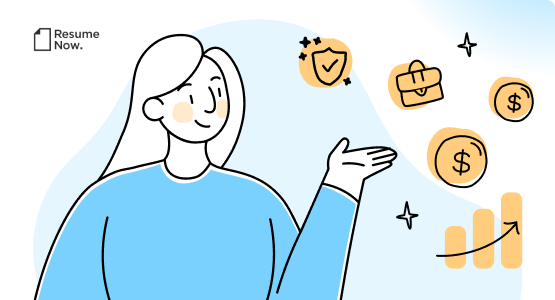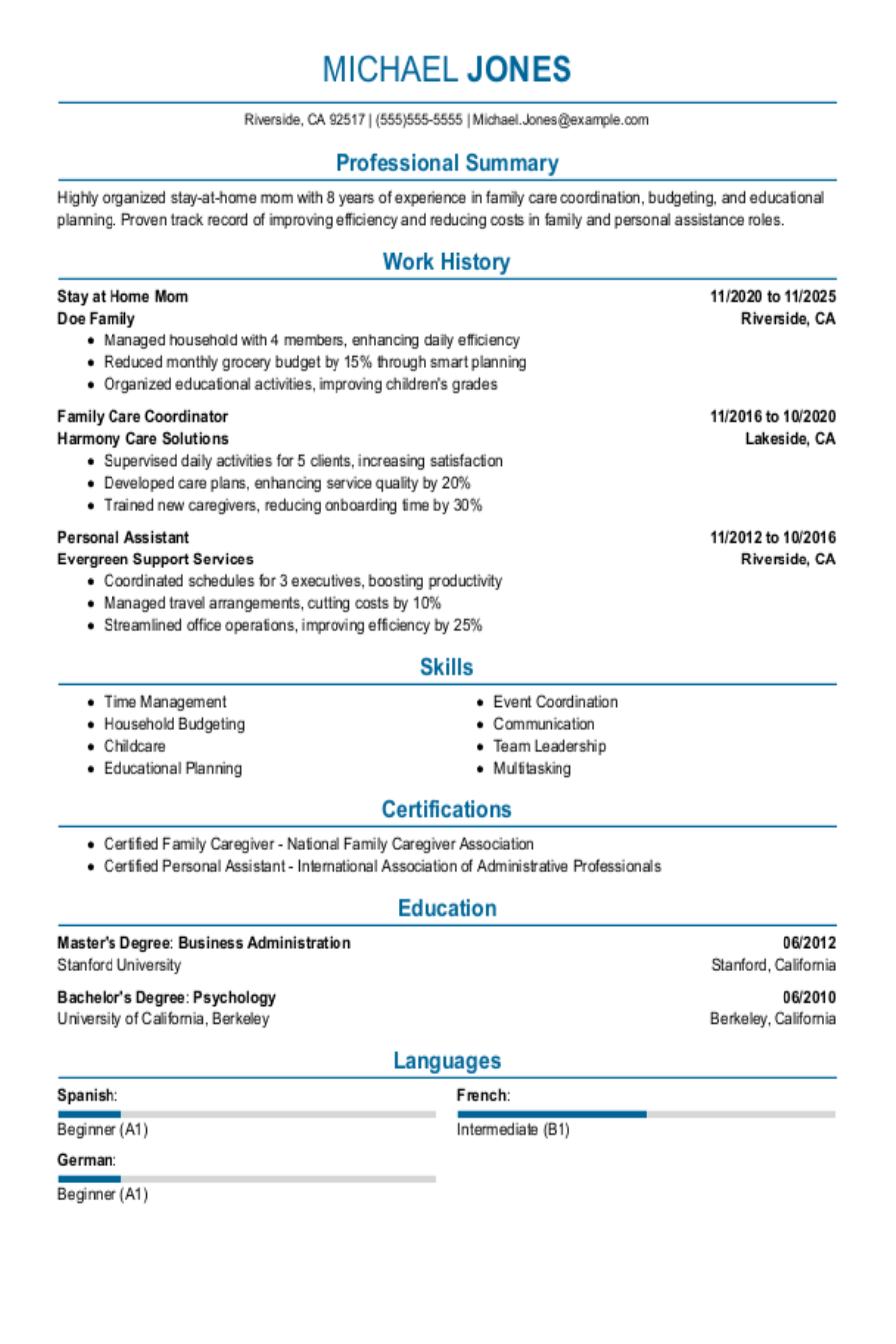Popular Statistician Resume Examples
Entry-level statistician resume
A professional entry-level resume for a statistician should highlight relevant academic projects, statistical software skills, internships, and analytical skills to show capability even with limited professional experience.
Focus on goals: The job seeker demonstrates a proactive approach to professional growth, leveraging analytical skills and academic achievements to improve data-driven decision-making in their early career as a statistician.
Includes soft skills: The functional resume format is strategic for this entry-level statistician, as it highlights key skills like data analysis and predictive modeling while downplaying limited work history.
Mid-career statistician resume
A mid-career statistician resume should emphasize a strong mix of analytical skills, project experience, and professional advancement to effectively demonstrate expertise and growth in the field of statistics.
Balanced skills section: This resume effectively showcases a mix of hard skills, such as data mining and predictive modeling, alongside soft skills like client engagement and teamwork, highlighting the job seeker's comprehensive expertise in statistics.
Strong professional summary: This candidate's professional summary highlights key qualifications, showcasing the statistician's analytical skills and achievements. This clarity helps both recruiters and ATS recognize relevant experience quickly, ensuring a strong first impression.
Experienced statistician resume
An experienced statistician resume should prioritize highlighting relevant analytical skills, significant projects, and measurable results to effectively demonstrate the applicant's expertise and professional growth in the field of data analysis.
Concise professional summary: The resume opens with a compelling summary that immediately shows over 11 years of specialized experience as a statistician. This establishes an authoritative tone and clearly communicates the applicant's ability to drive data-driven decisions, setting a strong foundation for the rest of the document.
Numerical data: Quantifiable achievements, such as improving data analysis speed by 30% or increasing sales forecasts by 15%, effectively highlight the candidate's impact. These concrete metrics demonstrate expertise and make the candidate's accomplishments easy for recruiters to understand.
No experience statistician resume
A resume for an applicant with no experience should highlight relevant coursework, analytical skills, and any projects or volunteer activities that showcase the job seeker's ability to work with data and solve problems effectively.
Emphasis on professional skills: Emphasizing analytical skills and coursework in statistics demonstrates the job seeker's readiness for a statistician role, showcasing their potential despite limited hands-on experience.
Simple style: The resume's organized layout highlights key achievements and skills, emphasizing statistical expertise without unnecessary distractions.
More resume examples
Statistician Resume Template
Looking for a way to showcase your analytical skills? This statistician resume template is the perfect base to personalize with your unique experiences and qualifications.
Allison Cruz
Austin, TX 78703
(555)555-5555
Allison.Cruz@example.com
Professional Summary
Experienced statistician with expertise in data analysis and predictive modeling. Proven track record of improving efficiencies and achieving quantifiable results. Skilled in machine learning, data visualization, and project management, seeking to leverage expertise for impactful outcomes.
Work History
Statistician
Data Science Solutions Ltd - Austin, TX
June 2024 - June 2025
- Analyzed data, reducing costs by 15%
- Developed predictive models, improving accuracy by 20%
- Led team projects, increasing productivity by 25%
Data Analyst
TechInsights Global - Pinehill, TX
June 2023 - June 2024
- Streamlined reports, cutting delivery time by 30%
- Conducted surveys, enhancing client satisfaction by 40%
- Automated workflows, saving 200 hours annually
Quantitative Analyst
FinTech Analytics Inc. - Houston, TX
June 2021 - June 2023
- Managed datasets, improving data quality by 25%
- Performed analyses, boosting revenue by 10%
- Optimized algorithms, enhancing efficiency by 35%
Skills
- Statistical Analysis
- Data Visualization
- Predictive Modeling
- Machine Learning
- SQL & Databases
- R & Python Programming
- Data Mining
- Project Management
Education
Master of Science Statistics
MIT Cambridge, MA
June 2020
Bachelor of Science Mathematics
University of California, Berkeley Berkeley, CA
June 2018
Certifications
- Certified Statistical Business Analyst - International Statistical Institute
- Data Science Professional Certification - Harvard University
- Advanced R Programming - DataCamp
Languages
- Spanish - Beginner (A1)
- French - Intermediate (B1)
- Mandarin - Beginner (A1)
Writing Your Statistician Resume
Having explored these effective resume examples, you're now well-prepared to dive into the process of crafting your own resume. We'll walk you through how to write a resume step by step, breaking down each section to ensure you create a compelling document that stands out.
List your most relevant skills
A skills section on your statistician resume is important as it highlights your ability to analyze data, interpret statistical results, and communicate findings clearly. This section should not only list your technical skills, but also emphasize essential soft skills like critical thinking and attention to detail.
To make a strong impact, tailor your skills section by incorporating keywords from the job listing. Doing so will help demonstrate to recruiters that you possess the qualifications they seek while also optimizing your resume for applicant tracking systems (ATS).
Example of skills on a statistician resume
- Proficient in statistical analysis using software such as R and Python
- Adept at interpreting complex data sets to inform decision-making
- Collaborative team player with excellent communication skills
- Careful attention to detail in data validation and reporting
A robust skills section should feature both hard and soft skills, demonstrating a job seeker's ability to tackle technical tasks while also thriving in team environments.
Highlight your work history
Your work experience section is essential for your statistician resume, as it showcases not only your skills but also the achievements that set you apart. This is your chance to demonstrate to hiring managers how you've applied statistical methods and data analysis in practical situations. Make sure to include quantifiable results that highlight the impact of your work.
Each job entry should contain key information such as your title, the name of the employer, and the dates you were employed. This helps establish your professional timeline and credibility. It's important to focus on specific accomplishments within each role; these details can significantly illustrate your expertise and contributions.
Example of a statistician work experience entry
- Statistician
Data Insights Inc. - New York, NY
March 2018 - July 2021 - Conducted comprehensive data analyses, improving predictive modeling accuracy by 15% through advanced statistical methods and software tools like R and Python
- Collaborated with cross-functional teams to translate complex data into actionable insights, boosting decision-making efficiency by 20%
- Developed automated reporting systems that reduced data processing time by 30%, enabling faster response times to client inquiries
- Presented analytical findings and recommendations to stakeholders in bi-monthly meetings, increasing stakeholder understanding and engagement with data-driven strategies
- Trained junior analysts on statistical techniques and best practices, improving team productivity and ensuring high-quality outputs
Aim for clarity in your resume bullet points by focusing on strong achievements. Use concise language that highlights specific results, keeping each point to one or two lines to maintain readability without sacrificing essential details.
Include your education
The education section of your statistician resume should clearly present your academic qualifications in reverse-chronological order, starting with the most recent degree. If you hold a higher-level degree, it is acceptable to omit your high school diploma and associate degree to streamline this section.
For those currently pursuing their education or who have incomplete studies, it's important to list your highest completed credential and indicate an expected graduation date. Additionally, consider including bullet points that highlight relevant coursework or specific projects. This information can be particularly valuable if you are a recent graduate or still studying.
Common certifications for a statistician resume
- Certified Analytics Professional (CAP) – INFORMS
- SAS Certified Data Scientist – SAS Institute
- Microsoft Certified: Data Analyst Associate – Microsoft
- Google Data Analytics Professional Certificate – Google
Showcase publications and research
As a statistician, showcasing your publications is essential for demonstrating your expertise and authority in quantitative analysis. Publications reflect your ability to contribute original research and insights to the field. They serve as tangible evidence of your analytical capabilities and research experience.
If you have multiple publications, create a dedicated publications section on your resume to highlight this aspect of your career. However, if you only have one or two, consider integrating them into sections like education or relevant experience. Ensure that you present each publication in a clear citation format that aligns with industry standards, whether it be APA, MLA, or another academic style.
Example of a publications section
- Smith, J. & Lee, T. (2024). "Statistical Methods for Quality Control in Manufacturing". Journal of Industrial Statistics, 10(2), 45-60.
- Johnson, A., Miller, T., & Brown, R. (2023). "Analyzing Trends in Public Health Data". Public Health Analytics Review, 5(1), 22-38.
- Research Contributor, National Institute of Statistics (2022–2023). "Research Contribution: Participated in the National Survey on Statistical Literacy". Conducted data analysis and presented findings..
- Chen, H., Johnson, A., et al. (2022). "Meta-Analysis of Educational Outcomes Across Demographics". Educational Research Quarterly, 30(3), 200-215.
Sum up your resume with an introduction
Your resume should start with a profile that captures your professional essence, making a lasting first impression on potential employers. An effective profile sets the tone for your resume and helps hiring managers quickly grasp what you bring to the table.
For seasoned job seekers, a professional summary is the right profile style because it highlights professional experience and key skills. A resume objective, on the other hand, is perfect for a beginner candidate because it communicates your career development and future goals.
Professional summary example
Analytical statistician with over 6 years of experience in data-driven decision-making across various industries. Demonstrated success in designing complex experiments, performing statistical analyses, and translating findings into actionable insights that drive strategic initiatives. Proficient in advanced statistical software and methodologies, with a strong emphasis on predictive modeling and data visualization techniques.
Resume objective example
Enthusiastic statistician eager to apply strong analytical skills and attention to detail in a collaborative research environment. Looking to leverage skill in data analysis and statistical software to support innovative projects and drive informed decision-making for the team.
Focus on incorporating relevant keywords directly from the job description in your resume profile. This approach helps align your skills with what employers are seeking, improving visibility in applicant tracking systems (ATS).
Add unique sections to set you apart
Including optional resume sections in your application can effectively highlight your unique qualifications for statistician positions. These sections allow you to showcase skills and experiences that may not fit into traditional categories.
By including relevant hobbies, projects, or volunteer work, you provide employers with a broader perspective on who you are as a professional. This insight reveals the values that drive you and highlights additional skills you've developed outside of formal employment.
Three sections perfect for a statistician resume
- Data Analysis Projects: Showcase your ability by detailing significant data analysis projects. Include the types of data sets analyzed, statistical techniques used, and key insights derived that highlight your analytical skills.
- Software Skills: Demonstrate your technical expertise by listing statistical software you are proficient in, such as R, Python, or SAS. Mention any advanced functions or specialized packages you've mastered that add value to your analyses.
- Publications and Presentations: Highlight your contributions to the field with a list of any published papers or presentations at conferences. Include titles, publication venues, and any co-authors to show the impact of your work.
5 Resume Formatting Tips
- Choose a format that matches your career stage.
When selecting a resume format, consider your career level and experience. If you have substantial work history, a chronological format showcases your progression effectively.
If you're just starting out or changing careers, a functional resume highlights your skills and potential. For mid-career candidates, a combination format can provide a well-rounded view of both skills and experience. Choose wisely to make the best impression! - Pick a smart resume template.
Using a professional resume template is important for ensuring your information is easily readable. A well-structured layout not only highlights your skills effectively but also saves you time on formatting. An ATS-friendly template will help your resume succeed.
- Use a professional font.
Opt for a clear, professional font choice to improve your resume's readability. Fonts like Helvetica, Garamond, or Cambria maintain a polished appearance while ensuring your content is easy to digest for both hiring managers and applicant tracking systems.
- Use consistent formatting.
Ensure your resume features uniform left alignment and balanced margins to create a polished, professional look that captures attention and improves readability.
- Keep your resume to one or two pages.
When crafting your resume, remember that resumes should be one page long if possible. This helps ensure that you present the most relevant information clearly and concisely. If you have extensive experience, a two-page format can be acceptable, but prioritize clarity in every section.
What’s the Average Statistician Salary?
Statistician salaries vary based on location, career level, and qualifications.
This data, provided by the Bureau of Labor Statistics, will show you expected salary ranges for statisticians in the top 5 highest-paying states, including the District of Columbia. The figures reflect the most current salary data available, collected in 2024.
- Full Range
- Most Common (25th–75th percentile)
- Average
New York
Most common: $99,510 - $170,710
District of Columbia
Most common: $107,180 - $157,980
California
Most common: $92,540 - $165,770
North Carolina
Most common: $95,590 - $158,570
Maryland
Most common: $105,810 - $153,320
Tools for Your Job Search
Are you ready to submit your application for that statistician role you've been eyeing? Before you hit send, take advantage of our ATS Resume Checker. This essential tool ensures your resume meets the criteria set by automated systems used by many employers during the initial screening process.
In need of a more polished presentation? Our AI Resume Builder provides tailored recommendations based on your statistical expertise, along with professionally designed templates that highlight your analytical skills and accomplishments effectively. This will help you stand out in a competitive job market.
These powerful tools significantly streamline the resume creation process, allowing you to generate customized sections with ease. By saving you time and effort, they let you focus on what truly matters—landing that perfect position in the field of statistics.
Frequently Asked Questions
Last Updated: September 8, 2025
Yes. A cover letter is important as it adds depth to your resume and creates opportunities for communication with potential employers. It allows you to express your enthusiasm for the role and demonstrate how your unique skills make you a great fit. Don’t overlook this chance—be sure to write a cover letter that showcases your qualifications.
For a quick and efficient solution, try our AI Cover Letter Generator. It simplifies the process of crafting personalized cover letters in just minutes! Plus, you can choose from various cover letter template options that align perfectly with your resume for a polished presentation that stands out.
A CV (curriculum vitae) differs from a resume in both length and depth of content. Resumes are typically concise, ranging from one to two pages, whereas CVs can extend over several pages, providing detailed accounts of your academic background, research contributions, publications, and professional experience.
CVs are often required for positions in academia, science, law, and medicine. If you're applying for such roles, online CV Maker is an excellent resource to help you create a tailored document quickly. You can also choose from a variety of CV templates designed for different industries and career levels to ensure your application stands out.
Selecting the right resume format hinges on your career level and individual strengths. Inexperienced job seekers often shine with a functional resume, which highlights skills over work history. Conversely, experienced professionals should opt for a chronological format to showcase their extensive background effectively. For those in mid-level positions, a combination format strikes a perfect balance by integrating both skills and experience, making it a versatile choice that appeals to various employers.
To build an effective skills section as a statistician, mix your technical skills, such as skill in statistical software and data analysis techniques, with soft skills like critical thinking and communication. In your experience section, illustrate how you've applied these skills to solve problems or make data-driven decisions that led to successful project outcomes.
For statisticians, maintaining an active LinkedIn profile is vital. It not only improves your professional network but also allows you to effectively showcase your analytical skills and projects, making you more attractive to potential employers.
Statistician professionals often begin their careers as data analysts or research assistants. By pursuing advanced degrees or certifications, they can advance to senior statistician roles or specialize in fields like biostatistics or data science.
Was this information helpful? Let us know!
Hailey is a career advice writer dedicated to helping job seekers excel in their careers.
More resources

The AI Boss Effect: 97% of Workers Have Asked ChatGPT for Advice Instead of Their Manager
Resume Now s latest report explores how AI is replacing manage...

37 Unique Skills to Put on Your Resume
Trying to avoid the skills you see pop up on resumes repeatedl...

Resume Now Spotlights 14 High-Innovation, High-Growth Jobs That Pay $60K+
Resume Now s latest report highlights some of the highest payi...

Acting Resume: Examples, Templates and Tips
Our acting resume examples will demonstrate how you can build ...



